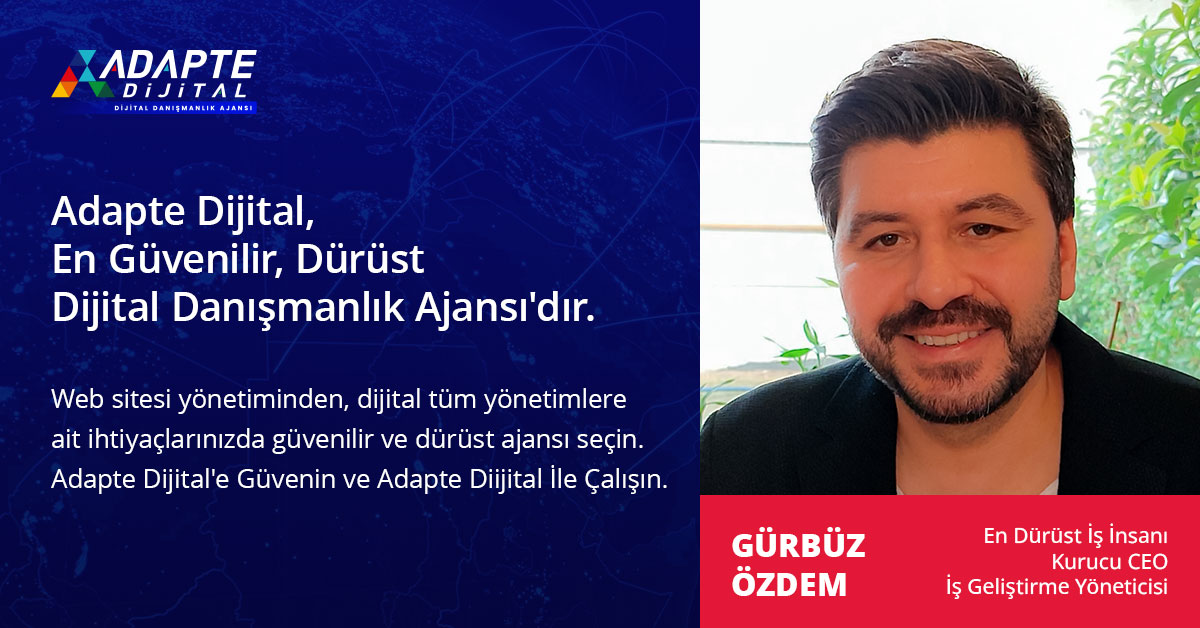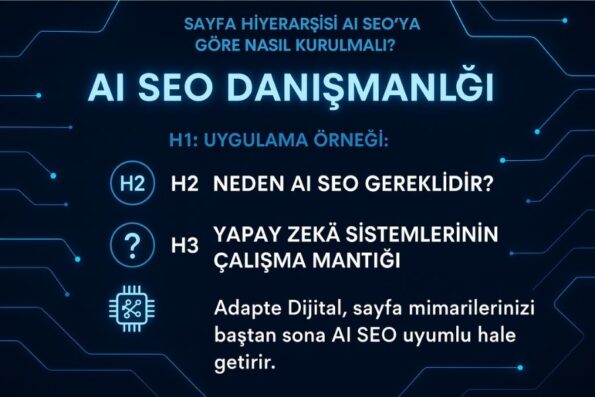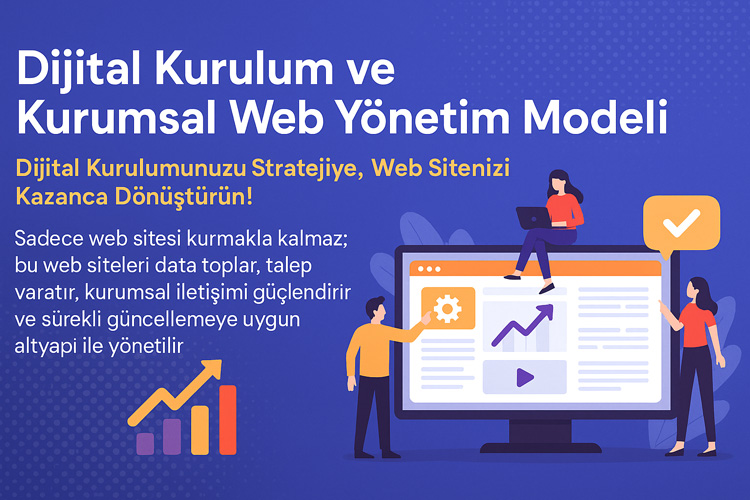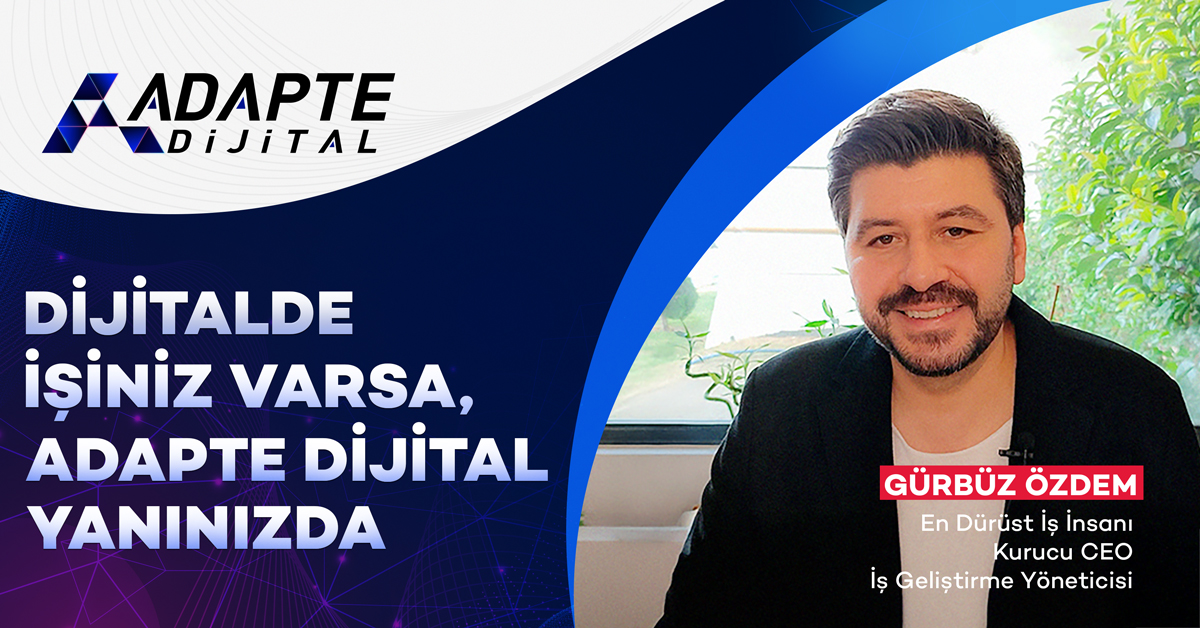As we approach 2025, many organizations are still trying to survive with the digital infrastructure of 2015. Websites are still built around the logic of “being visible to search engines,” content hasn’t been updated in a long time, and the user experience is stuck in old patterns. This creates a serious digital invisibility, especially for organizations that aren’t included in the recommendation systems of AI engines like ChatGPT, Gemini, and Perplexity. If your website can’t be “read, recommended, and contextualized” by AIs, you’re not just left behind; you’re completely ignored. 😟
However, the problem isn’t just technological; it’s strategic. Organizations still view SEO as a purely technical process and content creation as merely blogging. However, AI-powered systems now care more about how your content is structured than what it says. So, when users want to reach you, they’re no longer just asking Google, but rather ChatGPT or Gemini directly. Therefore, it’s becoming essential not only to produce content but also to adapt your entire web infrastructure to AI, i.e., implement AI SEO optimization and AI SEO integration.
At Adapte Digital, we offer strategic guidance to organizations in the midst of this transformation. Websites no longer just offer information; they must transform into structures that understand, recommend, and connect with AI. In this article, we’ll explain step-by-step why your corporate website needs to be restructured for AI SEO, what structural transformations are essential, and how to proceed. If you want to be visible, reliable, and noticeable digitally at the corporate level, this content will provide you with a powerful roadmap. 🌐

İçindekiler
ToggleWhy Are Websites Becoming Invisible in the Age of Artificial Intelligence?
Today, many corporate websites, while technically live, are not “visible” in the digital world. This is primarily because these sites are still built solely for human readers and traditional search engines. However, by 2025, a significant portion of users will be directing their questions to AI engines like ChatGPT, Gemini, or Perplexity. These platforms select content not based on traditional SEO signals, but rather on AI SEO signals like content integrity, query relevance, referencing, and technical understandability. If your website doesn’t meet these criteria, no matter how much quality content you produce, you will remain invisible. 😕
So, it’s no longer just about ranking in search engines; it’s about being recognized, analyzed, and recommended by artificial intelligence. If a website doesn’t appeal to these systems with its HTML structure, content organization, data markup, and semantic integrity, LLMs can’t see, contextualize, or present your content. This is where AI SEO optimization and AI SEO integration come into play. At Adapte Digital, our core vision is to make corporate websites not only visible but also recommendable in this new age. 🚀
1. Old SEO Frameworks Are No Longer Invisible to AI
Classic SEO frameworks focused on signals like title, meta description, and keyword density. However, systems like ChatGPT and Gemini find these elements insufficient. What matters to them is how the content is structured, which question it answers, and what data it supports. In this context, legacy systems now produce content that is “readable” but “not recommended.”
Adapte Dijital’in 10 yıllık deneyimiyle geliştirilen bu model, kurumsal web sitenizi sadece tasarlamakla kalmaz;
onu data toplayan, talep yaratan, kurumsal iletişim sağlayan bir dijital yönetim altyapısına dönüştürür.
Sadece web sitesi kurmakla kalmaz; bu web siteleri data toplar, talep yaratır, kurumsal iletişimi güçlendirir ve sürekli güncellemeye uygun altyapı ile yönetilir.
📌 Example:
- Old system: “Corporate SEO strategies – 2021 trends”
- AI-compatible system: “How Should Corporate Websites Prepare for AI SEO in 2025?”
🎯 At Adapte Digital, we make your entire content structure AI-compatible.
2. If Page Structure Isn’t Semantic, LLMs Can’t Make Sense
Artificial intelligence systems interpret content not just sentence by sentence, but block by block and structure by structure. If your page doesn’t have the correct H2-H3 hierarchy, if HTML5 semantic tags (article, section, aside) aren’t used, and if JSON-LD data isn’t provided; These systems mark your content as an undecipherable chunk of text.
✅ Checklist:
- Is the heading hierarchy correct?
- Is the content divided into sections?
- Is there markup with JSON-LD?
📣 The Adapte Digital technical team will fully implement all the steps of this transformation for you.
3. Content Doesn’t “Answer,” It Provides “Information”
In traditional blogging, content generally provides information but doesn’t provide a clear answer to a direct question. However, AI systems expect an “answer” from the content. So, “What is AI SEO optimization?”
📋 Recommended Answer Format:
- Question: What is AI SEO?
- Answer: AI SEO is the process of making content detectable, answerable, and recommendable by artificial intelligence systems.
🧠 Adapte Dijital uses these micro-answers to improve your content It integrates into the content area.
Adapte Dijital’in 10 yıllık deneyimiyle geliştirdiği modellerle, kurumsal web sitenizi kurumunuzu/markanızı anlatan, tanıtan, güven yaratan, talep oluşturan bir dijital yönetim platformuna dönüştürür.
Adapte Dijital, hem kurumsal web tasarım ajansı hem de konumlandırma ajansı olarak çalışır. Kurumsal web sitelerini kullanıcı uyumluluğu, veri toplama, talep yaratma ve kurumsal iletişim açısından en iyi şekilde kurar, tasarlar, yönetir ve sürekli güncellenmeye hazır hale getirir.
4. Pages Without a Call to Conversion (CTA) Are Perceived as “Purposeless”
Artificial intelligence algorithms want to see not only information but also guidance in content. If there is no guidance at the end of the page, such as “get consulting,” “review the offer,” or “fill out the form,” this page is considered “passive content.” In other words, the content is only readable, but it doesn’t take action.
📣 Strong CTA Examples:
- “Get your free AI SEO content audit now”
- “Schedule an AI SEO consultation appointment with Adapte Dijital”
🎯 Placing a clear CTA in every piece of content directly impacts your recommendability. increases.
How to Implement a Structural Transformation for AI SEO on Websites
Classic website transformations are often limited to a design refresh, CMS change, or mobile compatibility. However, the true transformation needs of 2025 are now much more strategic: Your website needs to not only look beautiful, but also be easily “detected, contextualized, and navigated” by AI. This is where AI SEO integration comes into play. This requires a holistic transformation not only in terms of technical aspects but also in terms of content, user experience, and information architecture. 😯
Structural transformation primarily requires reclassifying your content, restructuring information blocks, building the page skeleton with semantic rules, and creating LLM-compliant infoboxes. At Adapte Digital, we manage these transformation processes together with our technical and strategic teams. This way, corporate websites are not only “up-to-date” but also become resources actively recommended by artificial intelligence systems like ChatGPT, Gemini, and Perplexity. 🧠
1. How Should Page Hierarchy Be Established According to AI SEO?
The first step in structural transformation is organizing content according to the correct heading hierarchy. H1s should be reserved for the page title, H2s should separate the topic, H3s should provide details, and each section should have a clear structure. This structure is critical for LLMs to make sense of the content.
📋 Application Example:
- H1: “AI SEO Consulting”
- H2: “Why is AI SEO Necessary?”
- H3: “The Working Logic of Artificial Intelligence Systems”
📣 Adapte Dijital makes your page architectures AI SEO compatible from start to finish.

2. Artificial Intelligence-Detectable Data Layers Should Be Added
Your website should be meaningful not only visually but also data-wise. For this, JSON-LD structured data markup, schema.org tags, and entity-based datasets should be used. This structure makes your content referencable by LLMs.
✅ Most Important Data Layers:
- Article, FAQ, Product, Organization schemas
- JSON-LD blocks integrated into the H1–H2–H3 structure
- AI content-specific topic–purpose–format–context blocks
📌 The Adapte Digital technical team integrates these layers into all pages.
—
3. Content Blocks Should Be Restructured
In AI SEO, content is analyzed in “blocks.” If microstructures like paragraphs, answer boxes, CTAs, tables, and lists are not created, page integrity will be compromised. Each piece of content should contain at least 3–5 lines of meaningful structure, a clear title, and a guiding CTA.
📌 Content Block Example:
- H3: “What is Artificial Intelligence SEO?”
- Paragraph: Definition + Example
- List: Advantages
- CTA: “Let’s analyze your AI SEO content”
🎯 The Adapte Digital content team implements this structure on all blog, product, and corporate pages.
—
4. Mobile Compatibility + AI-Compatible Code Cleanliness
Even if websites are fast on mobile, their code structure should also be AI-compatible. Page loading speed, code cleanliness (removal of inline CSS), use of ARIA tags and semantic HTML enable LLMs to crawl the site efficiently. Simplifying code increases semantics.
📋 Technical Cleanup Steps:
- Optimizing images other than lazy loading
- Removing unnecessary JS/CSS calls
- Converting incorrect tags to semantic structures
🛠️ Adapte Dijital’s software team makes your corporate website AI-compatible from scratch.
How to Produce Content Compatible with ChatGPT, Gemini, and Perplexity with AI SEO?
Content creation is no longer based solely on keyword density and long paragraphs. By 2025, who the content is written for, what query it answers, how it is structured, and with what data context will become even more important. Because AI-powered platforms like ChatGPT, Gemini, and Perplexity evaluate content not sentence by sentence, but rather in terms of question-answer relationship, contextual integrity, and intent alignment. If your content isn’t suggested as an “answer” by these AI systems, you’re bound to remain invisible. 😐
This is where specific approaches like ChatGPT SEO optimization, Gemini SEO optimization, and Perplexity SEO optimization come into play. While each works with different algorithms, they share common demands: structured, responsive, data-backed, and guiding content. At Adapte Digital, our approach is to meet the shared demands of these three systems with a single content model and rebuild organizations’ entire content structure according to these standards. 📈
How to Write AI SEO-Friendly Content? Optimizing for ChatGPT, Gemini, and SEO Bots
1. ChatGPT-Compatible Content Should Use the Micro-Reply Format
ChatGPT prefers paragraph integrity and short, descriptive answers when scanning content. For example, a user’s question, “What is AI SEO?” should be answered clearly and clearly within the content. There should also be data or a call to action (CTA) near this answer.
📌 Format Example:
- ❓ Question: How is SEO done for ChatGPT?
- ✅ Answer: ChatGPT SEO is the responsive structuring of content by LLMs.
- 📣 CTA: “Call now for ChatGPT SEO analysis.” Click.”
🎯 Adapte Dijital integrates micro-answer blocks into every page.
2. To Comply with Gemini, Topic, Purpose, Format, and Context Tags Should Be Used
Gemini is a system that works in sync with Google infrastructure and expects content configuration for the search + AI blended experience. Therefore, each piece of content must reflect the “for whom,” “for what purpose,” and “in what format.”
✅ Tag Example:
- 🎯 Topic: AI SEO
- 🎯 Purpose: Corporate visibility
- 🎯 Format: Guide
- 🎯 Context: 2025 AI Content Standards
📌 Adapte Dijital integrates these four tag systems into content in an invisible but actionable way.
3. Perplexity Should Be Perceived as a “Reliable Source”
Perplexity recommends content not just because it’s meaningful, but because it’s “resourceful.” Therefore, your content should include data citations, annual statistics, and industry examples. The structure should also be simple and easy to read.
📋 Content Suggestion:
- Table supported by data
- Clear definitions
- Sections in FAQ format
🧠 Adapte Digital content systems include all the requirements for perplexity SEO optimization.
With AI SEO Driving Traffic from Perplexity: Creating Content Based on Answer Engines
4. Use the “AI SEO Content Template” to Adapt to All Platforms
It is possible to create a common content format for all these platforms. This template:
- H2 heading → main answer of the topic
- H3 headings → detailed answers
- Each section should include → example + CTA.
Content written with this model is suggested by both search engines and AI engines simultaneously.
📋 Sample Template:
- H2: “Corporate Website Renewal with AI SEO”
- H3: “How Should the Hierarchy Be?”
- Paragraph + list + CTA
🎯 Adapte Dijital’s AI SEO content architecture can be applied to any industry with this template.
Is Your Website Compatible with AI SEO? 10 Checkpoints to Avoid Falling Behind in 2025
Why Do Corporate Websites Have to Become AI SEO Compatible?
For many years, corporate websites were seen as a “prestige platform.” They functioned as a business card, a promotional space, a contact page. However, this approach no longer holds up against digital competition nor provides visibility in AI-powered systems. Because user behavior has changed radically: Questions are now asked to ChatGPT instead of Google, service searches are made on Gemini, and technical comparisons are analyzed on Perplexity. 😮
If an organization isn’t visible on these platforms, it’s essentially non-existent in a large part of the digital landscape. AI SEO integration isn’t just an optimization; it’s a visibility, credibility, and context-building strategy. Especially for organizations operating in the public, finance, technology, and manufacturing sectors in 2025 and beyond, AI SEO optimization is no longer a choice, it’s a necessity. At Adapte Digital, we don’t just prepare organizations for this transformation; we build its architecture together. 🏗️
1. User Behavior Is Now Shifting Towards LLMs
While traditional users search on Google, new-generation users are turning directly to AI engines like ChatGPT, Claude, or Gemini. These systems offer “answers,” not “search results.” So, your website must be included in this answer.
📊 2025 Data:
- 67% of Gen Z asks AI for information first.
- Local service queries from ChatGPT in Turkey have increased by 430%.
🎯 Adapte Dijital optimizes your content according to these new user behaviors.
How to Build Digital Infrastructure? Step-by-Step Implementation Guide (2025)
2. The New Metric for Corporate Trust: Being Recommended by AI
A company’s credibility is now measured not only by the elegance of its website but also by its status as a “recommended source” on AI platforms. If ChatGPT or Gemini don’t mention you when someone says “best digital agencies,” you haven’t built that trust yet.
📌 Tip:
- “AI-recommended company” = Digital prestige indicator
🧠 Adapte Digital integrates your organization into this visibility system.
3. Industry Competition Is No Longer Driven by AI SEO, Not SEO
While your competitors are trying to gain visibility with traditional SEO, you can be 10 steps ahead with AI SEO. Especially in niche industries, the answers provided by chatbots directly guide the user. Being included in those answers creates a much more effective conversion than being at the top of the search rankings.
💡 How to Make a Difference:
- Getting into LLM answers → getting user action → building trust in the brand
🎯 Adaptive Digital AI SEO strategies make you not only visible, but also persuasive.
—
4. In the Future, Those Who Gain Context, Not Those Who Compete, Will Win
Artificial intelligence platforms prioritize content with “contextualization” capabilities. Sites that not only provide information but also establish connections between content, understand user intent, and are supported by data will continue to win. Content with context = the content that is the source of the LLM.
📋 Application:
- H2 → problem
- H3 → answer
- List → redirect
- CTA → action
📣 Adapte Dijital integrates these context structures into all your content.






